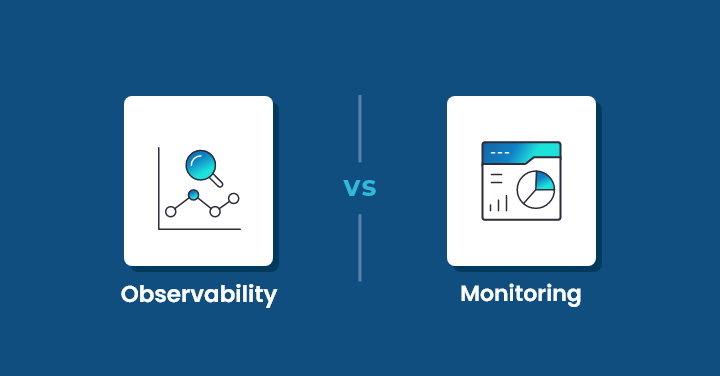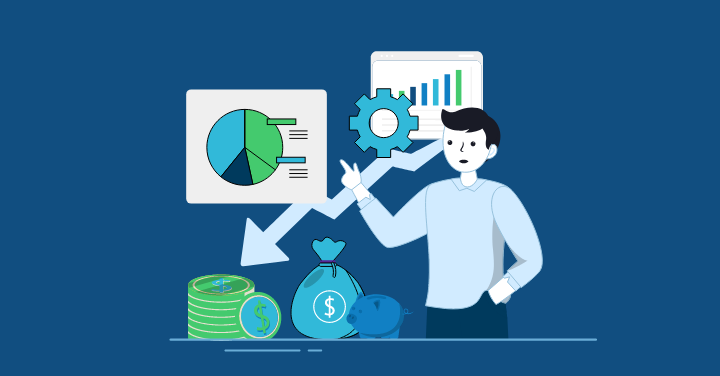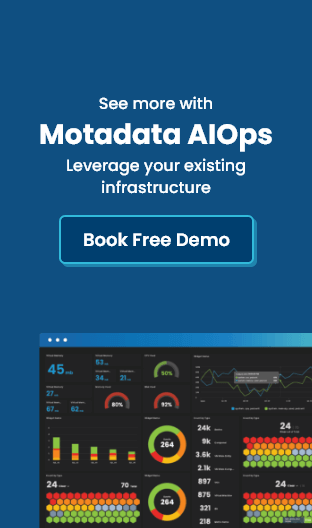In 2021, a major cloud provider experienced a global outage that took down multiple high-traffic websites and services for hours. Amazon, PayPal, Reddit, and the New York Times were a few popular websites that became the victim of this mishap. In spite of having some of the popular monitoring tools in place, engineers found it difficult to identify the root cause from the logs, metrics, and traces. This incident wasn’t unique as it reflected a growing challenge for organizations managing complex IT systems.
Observability, the ability to understand the internal states of a system using log data, metrics, and traces, has become essential for modern IT operations. This new approach is allowing teams to monitor performance, detect anomalies, and resolve issues better.
Microservices, cloud-native platforms, and continuous deployments are taking over various traditional practices. Manual monitoring and reactive responses are no longer enough to manage these complex digital infrastructures. Some of the common issues that businesses face with traditional methods are alert fatigue, slow root cause analysis, and missed signals.
This is where Artificial Intelligence (AI) in observability comes into play. With AI comes automation, intelligent alerts, and predictive capabilities that not only keep pace with IT complexity but often stay one step ahead.
Soon, AI will transform observability by enabling faster detection features and accurate insights into complex IT systems. Thus, helping businesses move from reactive to proactive approach. In this blog post, we will cover how AI in observability will benefit you in the long run and what challenges you need to be prepared for.
The Growing Complexity of Modern IT Systems: A Need for Smarter Observability
Modern IT systems have evolved over the years, driven by digital transformation and the need for continuous innovation. This evolution has benefitted businesses in many ways but at the same time made it more challenging than ever to monitor and manage these environments. The widespread adoption of microservices and distributed architectures is one of the major reasons behind this challenge. A few more trends fueling this complexity, include:
Microservices and distributed architectures:
Unlike traditional monolithic applications, microservices split functionalities across multiple independent services. Thus, making it difficult to manage and monitor each service in real-time. Instead of a single application, businesses now run hundreds or thousands of loosely coupled services.
Cloud-native and multi-cloud environments:
Organizations are no longer operating within the boundaries of a single data center. Workloads span public clouds, private data centers, and edge environments, each with its own configurations. This fragmented infrastructure makes it difficult for IT professionals to gain visibility over each cloud service and monitor it in real-time.
CI/CD pipelines and DevOps culture:
Teams are deploying code faster and more frequently than ever before. Thus, increasing the chances of performance outages or bug creation that may impact performance. Further, old monitoring tools are not enough to trace such issues in a fast-paced environment.
Exploding data volume:
Each system, service, and container emits vast amounts of telemetry data – logs, metrics, and traces on a daily basis, making it nearly impossible for humans or traditional tools to manually analyze and correlate this information.
Traditional observability tools struggle in this environment because they were designed for simpler, more static systems. They often rely on fixed thresholds, siloed data sources, and manual analysis, which are insufficient for today’s distributed IT environments. As a result, teams are left with blind spots, delayed incident detection, and prolonged resolution times.
To keep up with this, organizations need to invest in something smarter like AI-driven observability solutions. These powerful solutions use machine learning techniques to detect patterns, correlate data across environments, and generate actionable insights. Thus, enabling teams to better manage their IT systems and improve decision-making.
How AI Enhances Observability: Key Applications and Benefits
It is quite difficult for traditional observability tools to keep up with the variety of telemetry data in the growing, complex IT environment. Further, gaining visibility over distributed and complex hybrid and multi-cloud environments is a big challenge with traditional observability tools. This is where infusing Artificial Intelligence (AI) into observability turns the table. This transformative approach is not capable of only detecting issues faster but also predicting and preventing them. Here are a few key applications and benefits of AI-enhanced observability.
Intelligent Alerting and Anomaly Detection
Finding potential problems in real-time before they escalate is a big challenge in complex IT systems. In traditional monitoring systems, organizations relied majorly on static thresholds to trigger alerts.
However, the major problem with these systems was they usually failed to update on natural fluctuations in system behavior resulting in missed anomalies or false positives.
AI algorithms, on the other hand, can learn the baseline of normal system behavior over time. With AI and machine learning techniques, observability platforms can not only spot anomalies but also reduce false alarms.
Hence, allowing IT teams to focus on more real, critical issues. AI can even track small patterns, such as a sudden spike in metrics during a seasonal campaign or a drop in user requests. AI also helps reduce alert fatigue, a common issue where IT teams are overwhelmed by an excessive number of low or false alerts.
These even come with predictive capabilities, i.e., they can identify issues early by analyzing historical patterns and trends. This proactive approach helps improve reliability and user satisfaction.
Automated Root Cause Analysis
Another major benefit of AI in observability is automated root cause analysis. Pinpointing the root cause of a problem using traditional methods could be quite challenging in a complex IT environment.
However, AI can look through telemetry data and find out the issue quite easily. Using techniques like correlation analysis, AI systems can find patterns in telemetry data.
Let’s say, the application became slow to process suddenly. If you had an AI-based observability tool, you could easily track the link between network layers, applications, and databases. Thus, helping find bottlenecks faster and easily. It monitors connected telemetry streams to identify the problem and understand from where it is coming, i.e., server or a bad API.
Basically, Dependency mapping is another AI-powered technique that maps interactions between services and infrastructure components. By understanding these dependencies, AI can trace the cause of failure or performance issues.
Pattern recognition is another capability that allows AI systems to learn from historical data and reduce Mean Time to Resolution (MTTR) or boost operational efficiency.
Predictive Analytics and Capacity Planning
AI-enabled predictive analytics goes beyond troubleshooting. AI excels at predicting data and insights based on historical data which is quite helpful for capacity planning. By analyzing long-term trends in resource utilization, i.e., CPU, memory, network bandwidth, etc, AI can predict when resources will reach critical levels. Thus, helping in running stable operations.
Further, these insights ensure that infrastructure is scaled appropriately before performance bottlenecks occur. It also helps avoid over-provisioning, which leads to wasted resources and higher operational costs. AI-based capacity planning also plays an important role in supporting cloud cost optimization by analyzing workload patterns and usage trends. Businesses can save money and ensure smooth operations by implementing AI into observability.
Enhanced Data Visualization and Insights
Efficient decision-making demands accurate data. Observability tools generate a large volume of data but making sense of it can be daunting. This is where AI helps with data visualization and actionable insight generation. Rather than requiring engineers to change raw telemetry input, AI surfaces meaningful patterns and trends automatically. These AI-based tools feature intelligent dashboards that highlight anomalies, dependencies, and other events in a meaningful manner. These dashboards prioritize critical information, providing real-time summaries that are easy to interpret.
Further, users can use natural language to query and interact with observability data. From the insights collected and visualizations, IT managers and DevOps teams make smart choices. These not only help save time but empower non-technical stakeholders to understand system behavior and performance.
Automated Remediation
AI has made issue detection quite simple but another area that got uplifted using this practice is automated remediation. Once AI identifies the root cause of the problem or identifies an issue, it can go a step further by initiating a response without human intervention. Observability platforms with AI continuously look for unusual patterns and take action as soon as they recognize the problem. They use pre-defined scripts to spot issues like errors in settings or server overload.
For instance, if AI detects that a specific service is consuming too much memory, it can automatically restart the service or increase memory allocation. This level of automation reduces downtime, minimizes human error, and speeds up recovery times. Automated remediation also works towards creating self-healing systems and enabling IT operations teams to focus on more strategic tasks.
Real-World Examples and Use Cases
AI-powered observability platforms are having a big effect on IT operations. For example, big companies use these platforms to handle systems that are spread out in hybrid cloud environments. They use automated root cause analysis and action trigger workflows. This helps to lower the mean time to resolution (MTTR) and improve system performance when it is busiest. At the same time, it enhances the overall user experience.
Another great example is in retail. During the holiday season, predictive analytics help businesses deal with sudden changes in customer traffic. By adjusting operations and fixing bottlenecks, observability tools make sure that shopping runs smoothly. These real-world applications show how an observability platform can bring both reliability and innovation to modern businesses.
Challenges and Considerations for Implementing AI in Observability
No doubt, AI-powered observability tools come with a wide range of benefits that will help improve IT operations. But, implementing it successfully is a big challenge. Organizations need to consider several factors and address areas that help enhance the process rather than complicate it. Here are a few challenges and best practices that can help build an effective AI-driven observability strategy:
Data quality and preparation requirements for AI models.
For effective performance, it is important that AI models receive a large volume of clear and relevant data. In case your observability data is unstructured or inconsistent across systems, feeding such data into AI models may result in inaccurate predictions.
The big challenge is collecting clean and structured telemetry data from different systems. The task of data preparation requires a lot of preprocessing and tagging, implementing data normalization techniques, and use of automated data pipelines for cleaning data before feeding into AI models. Continuous data validation is also essential to maintain the integrity of the models over time. By implementing this best practice, organizations can standardize observability practices around AI models and generate accurate insights.
The need for skilled data science and engineering teams.
The use of AI in observability needs skilled data science, engineering, and system design teams. AI implementation is not limited to only installing the tool but covers other roles, including building, training models, and interpreting outputs. Many organizations lack experienced team members or professionals who have expertise in data science, DevOps, and IT operations.
Engineering teams play a key role in smooth data collection and monitoring setup. Experienced data scientists are essential for adjusting machine learning models to fit the organization’s needs. Finding such people with the right skills is a big challenge.
Hence, companies should invest in training internal teams or partnering with external AI specialists. Organizations must also aim to maintain cross-functional collaboration to align model outcomes and boost efficiency across different situations.
Integration with existing observability tools and workflows.
Today, many organizations have their own monitoring and logging tools. Each of these tools has its own data formats and operational models. Integrating AI into these existing observability tools can be a challenge as it may disrupt ongoing system monitoring or create silos.
Let’s say, you have already been using an application performance monitoring (APM) tool and now need to connect it with tools that have AI features. In order to achieve this, it is important to find platforms that support workflow integration and not override. Further, select AI tools that support open standards like OpenTelemetry and are flexible.
Addressing potential bias in AI models.
AI in observability needs to be protected from AI bias. AI systems trained on biased data can produce skewed results and unethical insights. This can be extremely risky in large-scale IT environments where even a minor error can cause major issues. Further, AI bias can change the predictions and results in production.
Hence, to mitigate bias, it is important to diversify training datasets and use algorithms that detect and reduce issues. Regular model audits and implementation of governance policy are also essential. By taking these steps, they build greater trust.
Ensuring trust and transparency in AI-driven insights.
To connect AI-driven observability and decision-making, trust and transparency are crucial. IT teams need to understand how AI arrives at specific conclusions or helps make important decisions.
One way to do this is by implementing explainable AI (XAI) techniques in observability platforms for clear outputs. This will add more transparency and enable team members to view why some telemetry patterns are seen as problems. Further, talking openly about AI-driven decisions helps build trust.
The Future of AI-Powered Observability
With the IT ecosystem becoming more and more complex, relying on traditional observability tools is not enough. Integrating AI into observability is emerging as a powerful solution to bridge this gap. But, AI’s role in observability is just beginning. In the future, you may observe more powerful trends, developments, and capabilities, such as:
- Advanced AI algorithms and machine learning techniques: Innovations in deep learning, reinforcement learning, etc., will improve AI’s ability to understand complex behaviors, predict system degradations, and recommend appropriate solutions before problems occur or impact. It will further improve the accuracy of AI systems by learning from historical data and making improvements.
- Increased automation and self-healing capabilities: Apart from real-time problem detection, these tools will come with the ability to automatically remediate workflows. In case of performance degradation, the tool will automatically trigger a pre-defined plan that will reduce downtime.
- The role of explainable AI (XAI): This trend will help clarify how models arrive at decisions, offering more transparency and trust-building among developers, operations teams, and business stakeholders.
The evolution of AI-powered observability in the future will enable IT operations teams and experts to not only react but also anticipate, adapt, and auto-correct in real time. There will be a shift from reactive monitoring to a predictive approach where AI will guide IT teams through complex issues and ensure better performance and availability.
Conclusion
With new technologies and constant upgrades, complex IT systems are going to stay here for the long term. Traditional observability tools will struggle to provide the visibility and speed required to manage such environments. The old-school methods are no longer enough to manage complex, distributed architectures or cloud services. They lack visibility and identifying issues in real-time is a big challenge for team members. This is where AI will make its way and transform observability from a reactive practice into a proactive practice.
With AI in observability, businesses can gain a lot of benefits, including intelligent alerting, automated root cause analysis, predictive analytics, and self-healing systems. Further, they provide clear visibility into all systems – logs, metrics, and traces that make it easier to identify the root cause of the problem and provide appropriate solutions. As a result, all these features provided within AI-based observability tools empower team members to resolve issues faster and optimize their performance.
In the coming time, AI will not only support IT operations, it will redefine them. Hence, organizations that embrace AI-driven observability today will gain a critical edge over their competitors. Start your journey today by investing in Motadata’s unified observability platform.






